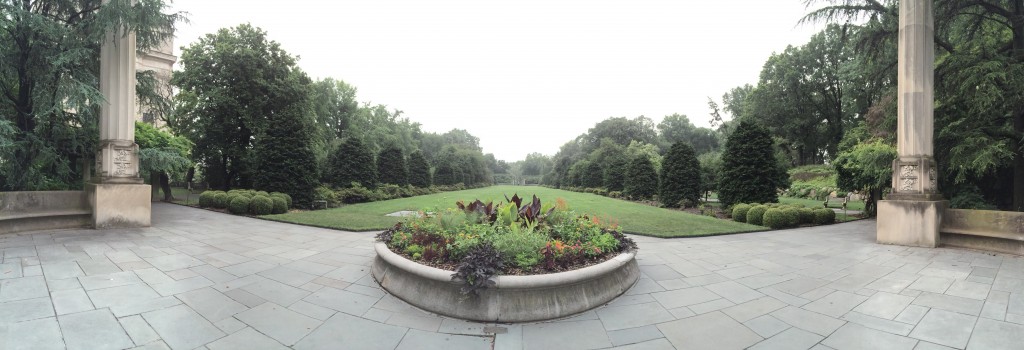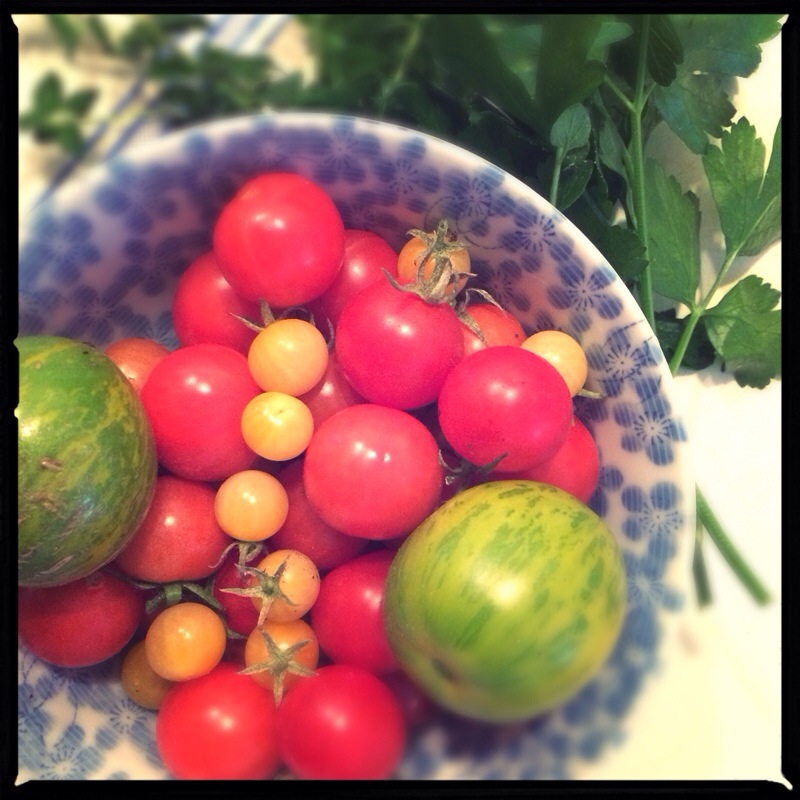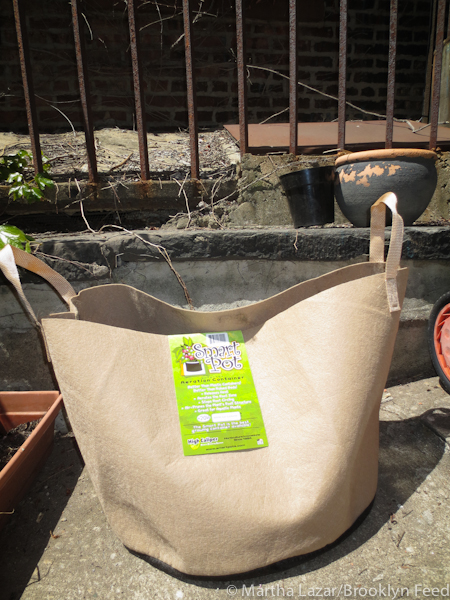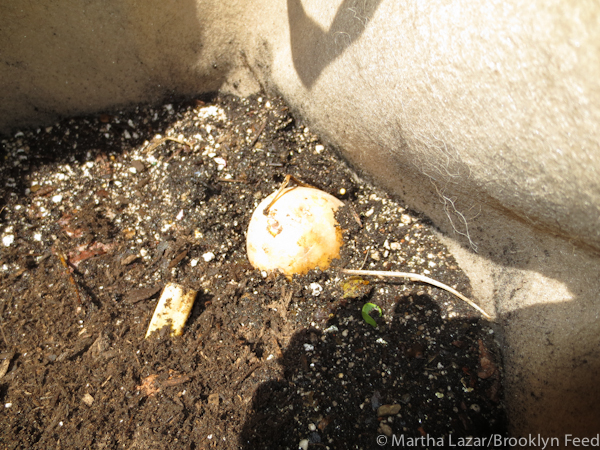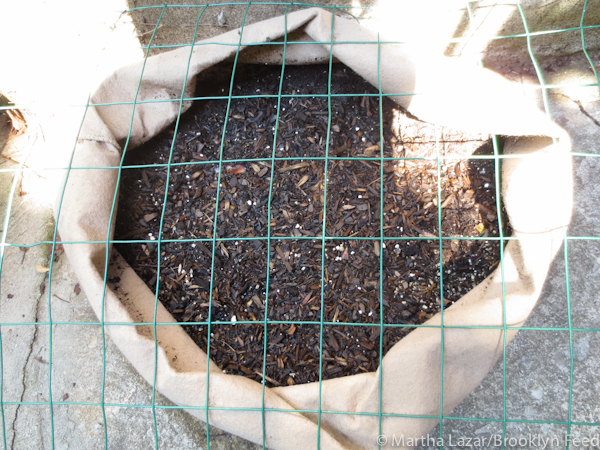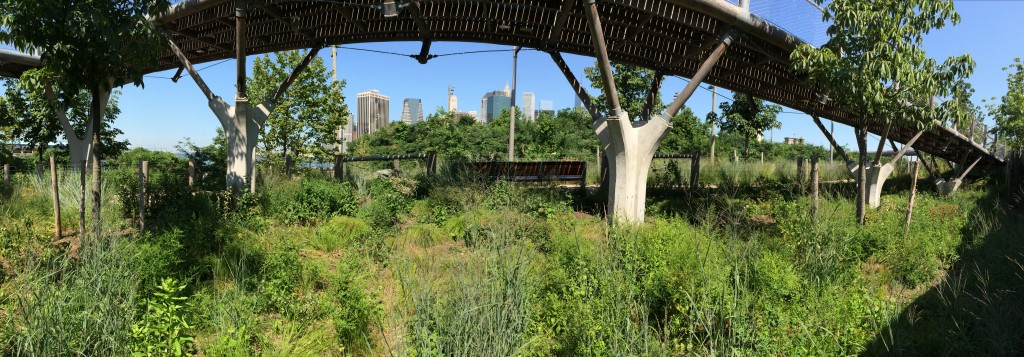 One of the fun things about gardening at Brooklyn Bridge Park is all the different spaces. There are fields with regular grass and trees, wetland areas, tidal pools, bamboo thickets and native grass meadows. These photos are from when I was weeding in one of the native grass areas. There is a walking bridge above connecting Brooklyn Heights to the park. This particular area is filled with native grasses and sedges, which was a good challenge in identification for me. I had to pull the weeds and invasive grasses, but leave the native stuff. It was really tricky at first, but eventually I was able to really see the differences in coloration and blade texture.
One of the fun things about gardening at Brooklyn Bridge Park is all the different spaces. There are fields with regular grass and trees, wetland areas, tidal pools, bamboo thickets and native grass meadows. These photos are from when I was weeding in one of the native grass areas. There is a walking bridge above connecting Brooklyn Heights to the park. This particular area is filled with native grasses and sedges, which was a good challenge in identification for me. I had to pull the weeds and invasive grasses, but leave the native stuff. It was really tricky at first, but eventually I was able to really see the differences in coloration and blade texture.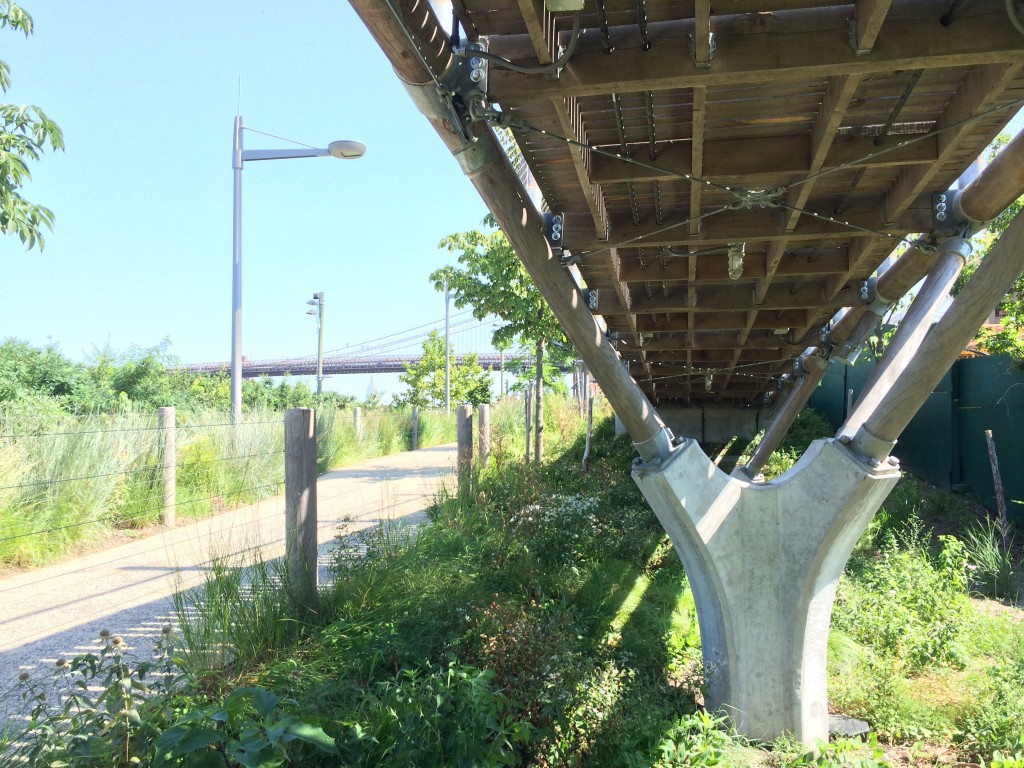 When I got home I ordered a copy of the book Wild Urban Plants of the Northeast. It was recommended to me to help in weed identification. And if that doesn’t prove my nerdiness, check out these cool “bird’s nest” mushrooms I saw while weeding.
When I got home I ordered a copy of the book Wild Urban Plants of the Northeast. It was recommended to me to help in weed identification. And if that doesn’t prove my nerdiness, check out these cool “bird’s nest” mushrooms I saw while weeding. 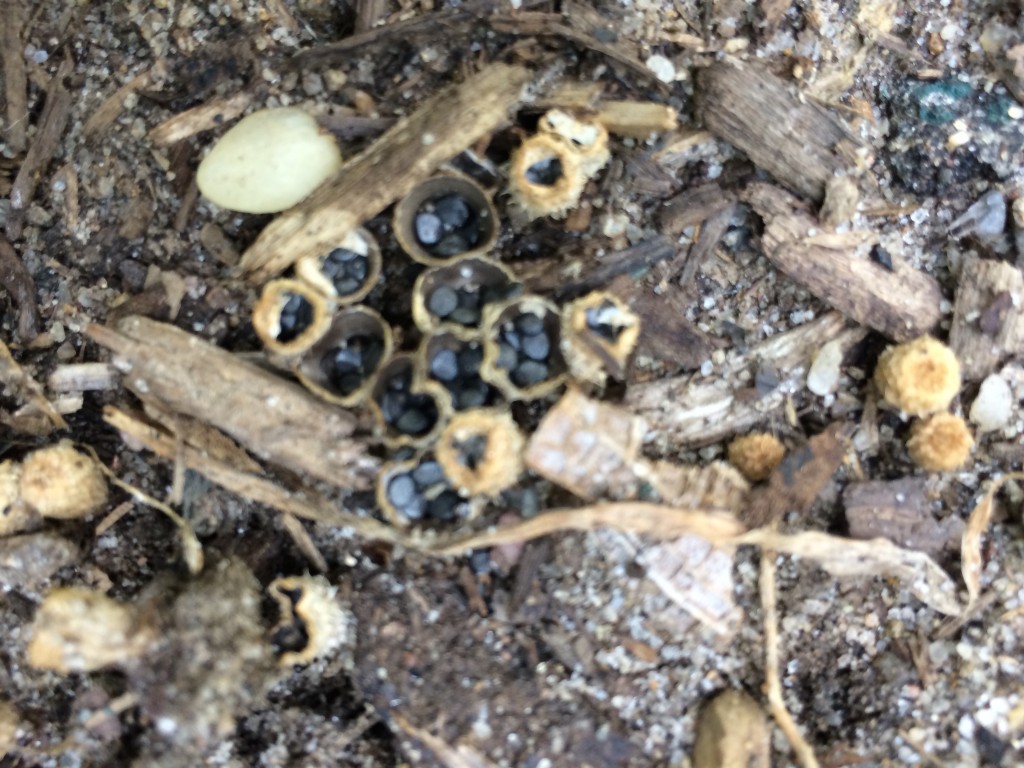 It’s a lousy phone photo where I was trying to get too macro, but if you squint you can see them. There are a few light orange circles that are the mushrooms. When the mushroom wants to spread its spores, the top comes off to expose them. They are the tiny black disks that look like bird’s eggs sitting in a nest. C’mon, you have to admit they are cool!!
It’s a lousy phone photo where I was trying to get too macro, but if you squint you can see them. There are a few light orange circles that are the mushrooms. When the mushroom wants to spread its spores, the top comes off to expose them. They are the tiny black disks that look like bird’s eggs sitting in a nest. C’mon, you have to admit they are cool!!
Category Archives: gardening
Budding Horticulturist
I’ve been doing some volunteer gardening work at a couple of different places here in Brooklyn. Two days a week you can find me in the native plant gardens at Brooklyn Bridge Park. One day a week I’ll be digging away at the Osborne Garden, which is in the Brooklyn Botanic Garden and pictured above. I am learning a lot about native plants vs. weeds. I also feel a bit like a home cook amongst chefs. I am used to gardening on a much smaller scale, so I think I’m a bit too precious when I’m weeding. It will be interesting to learn tips on how to speed things up.
Postcards from the Cloisters
On Saturday we went to visit the Cloisters. We had a beautiful Spring day, which was perfect as the gardens at the Cloisters are as stunning as the museum. The medieval artwork was a great mix of stunning and creepy, with several reliquaries to tip the scales towards creepy.
We lucked out and went on their Garden Day, so we were able to hear about one of the lovely gardens. That particular garden was divided into sections including a culinary and household bed, an arts & crafts bed with dye plants (weld, madder, woad, indigo, nettles), a magic bed (deadly nightshade, dragon arum, mandrake), a brewer’s bed (licorice, hops, ground ivy, costmary). In the center of all of these beds were 4 lovely quince trees, and there were espaliered pear trees along the outside walls.
Of course there were the famous unicorn tapestries, but one of the most amazingly detailed piece was this rosary bead. How the artist carved such detail boggles the mind.
The view from the garden shows the protected Palisades.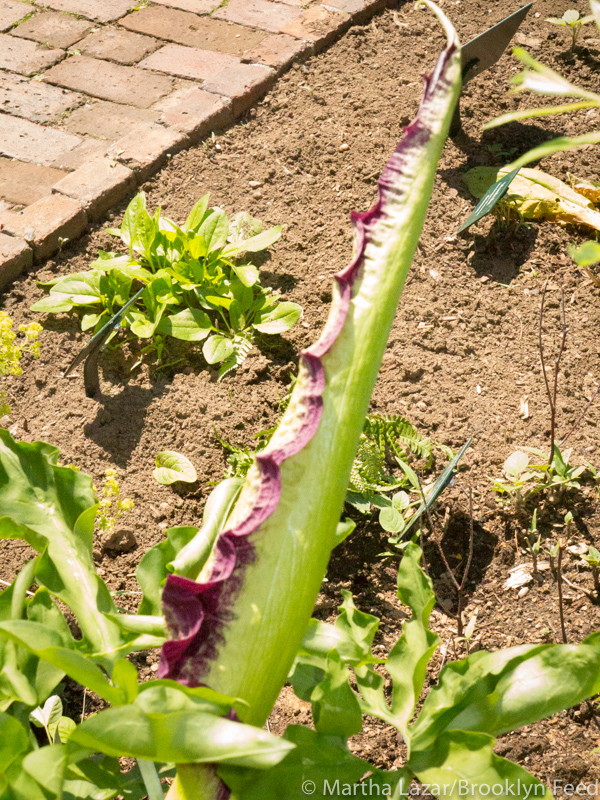 Dragon Arum. This bud was getting ready to open. It was about 2 feet long, and when open smells like rotting meat. It was considered an aphrodisiac based on it’s form. I may be more pure at heart because I thought that the bud really looked like a dragon’s tail.
Dragon Arum. This bud was getting ready to open. It was about 2 feet long, and when open smells like rotting meat. It was considered an aphrodisiac based on it’s form. I may be more pure at heart because I thought that the bud really looked like a dragon’s tail.
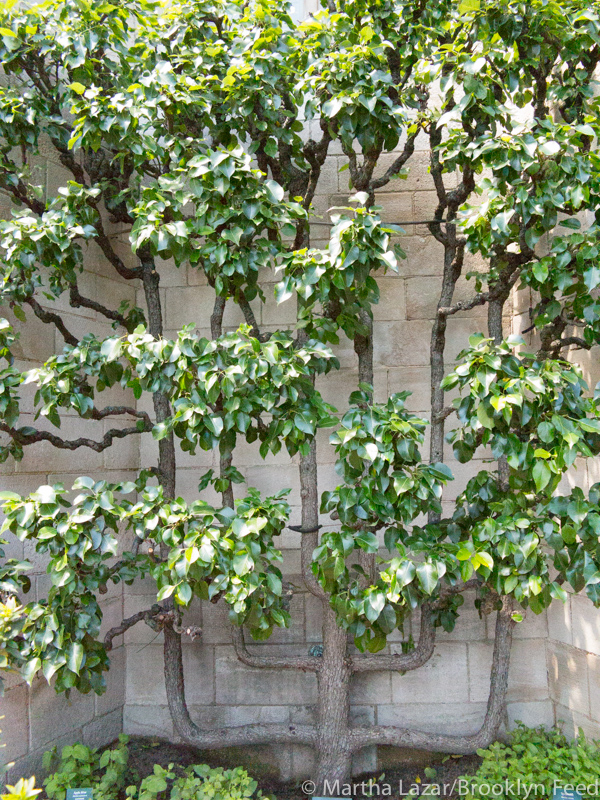 Espaliered pear tree
Espaliered pear tree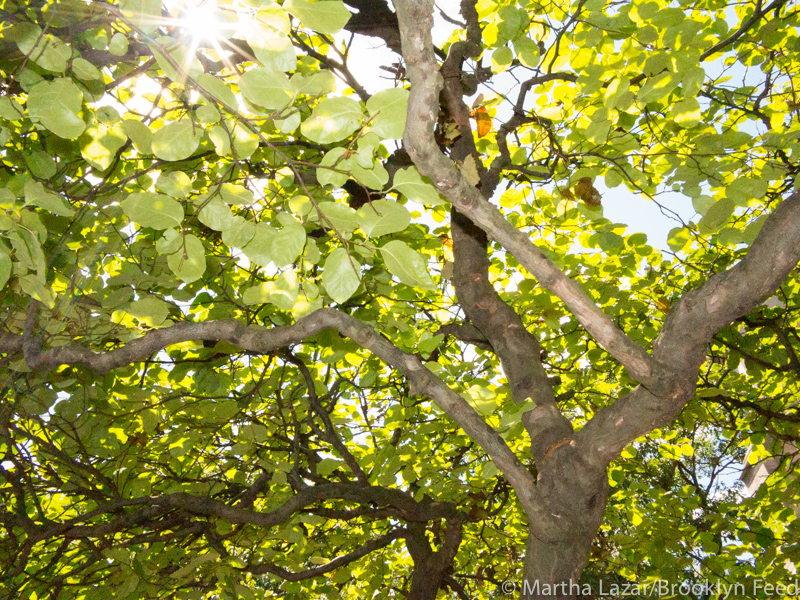 Quince tree
Quince tree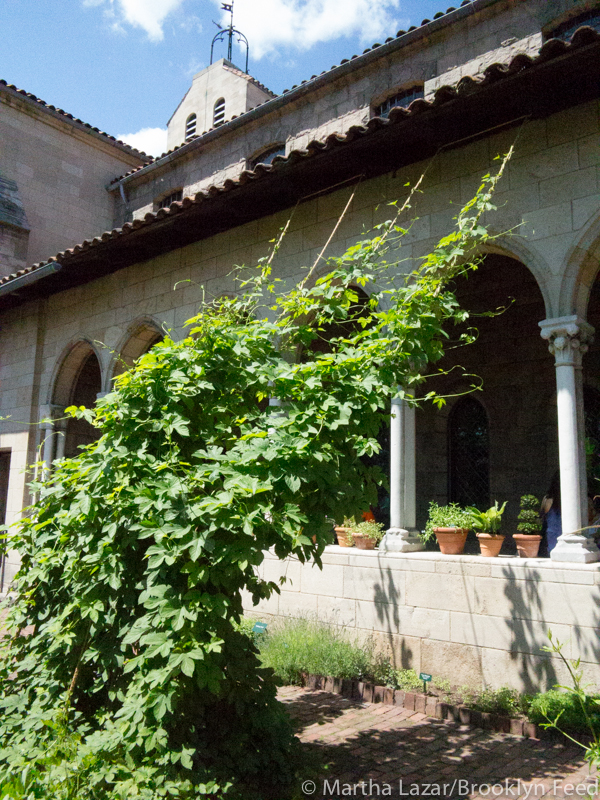 Hops growing in the brewing bed
Hops growing in the brewing bed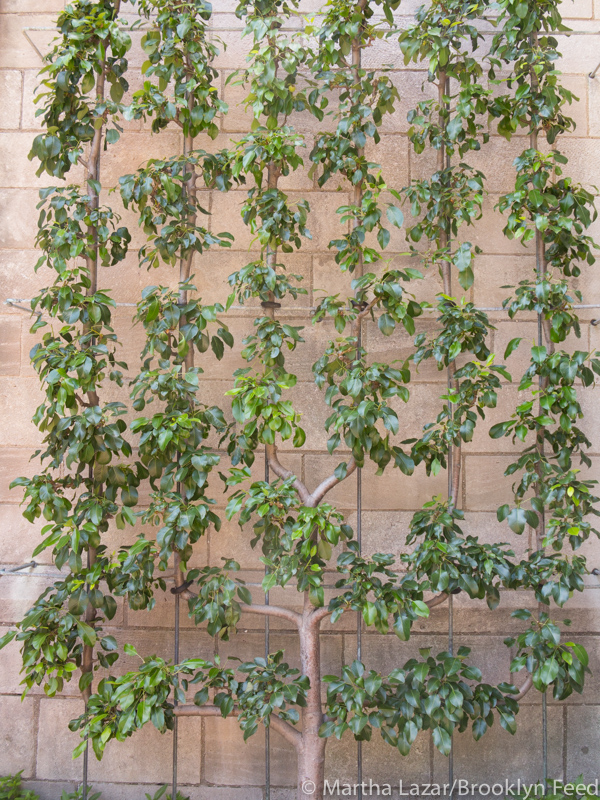 Another espaliered pear tree
Another espaliered pear tree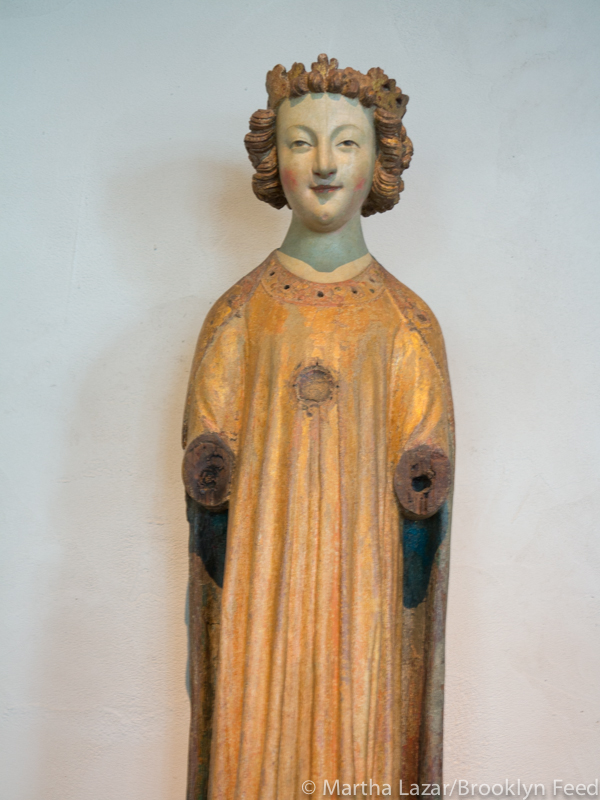
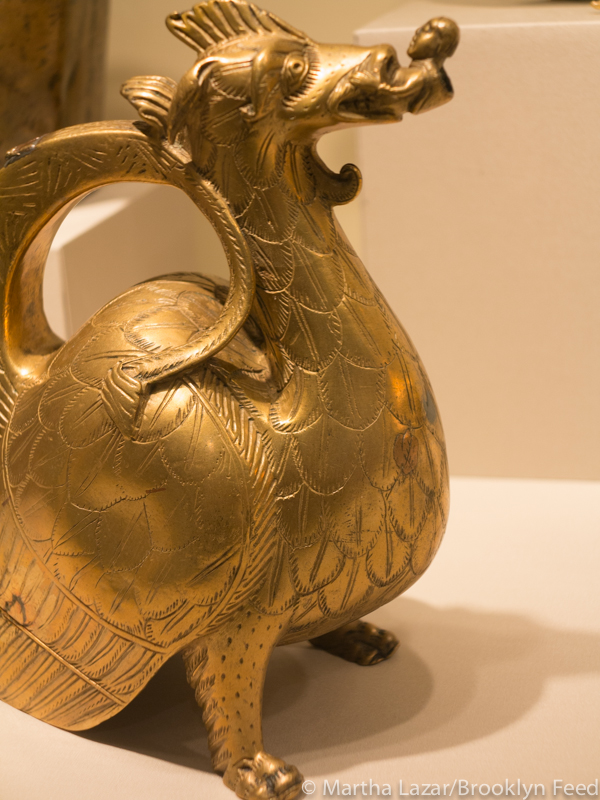 I love this water pitcher. Check out the little man in the dragon’s mouth.
I love this water pitcher. Check out the little man in the dragon’s mouth.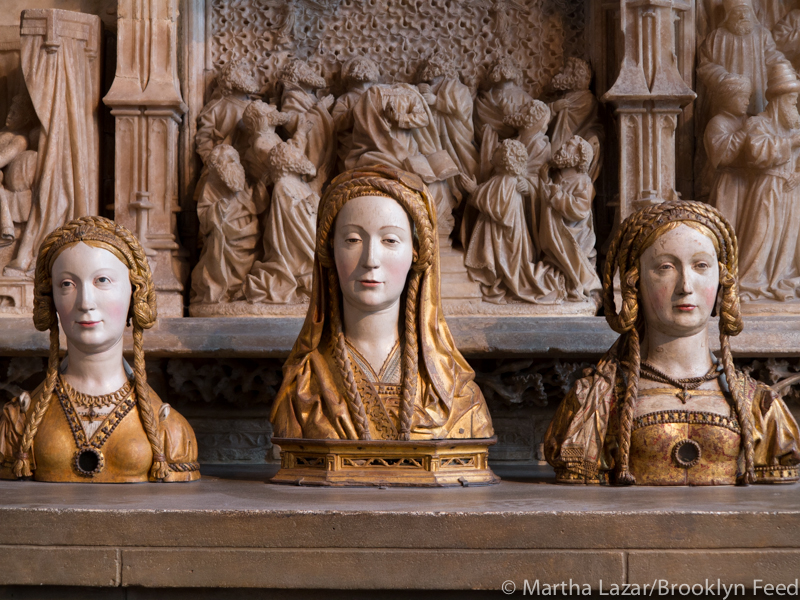 These ladies were reliquaries of saints. The shape of the relic often depicts what it contains. So I guess we’ve got 3 skulls inside. The carving and painting was stunning, but I think their expressions are wonderful.
These ladies were reliquaries of saints. The shape of the relic often depicts what it contains. So I guess we’ve got 3 skulls inside. The carving and painting was stunning, but I think their expressions are wonderful.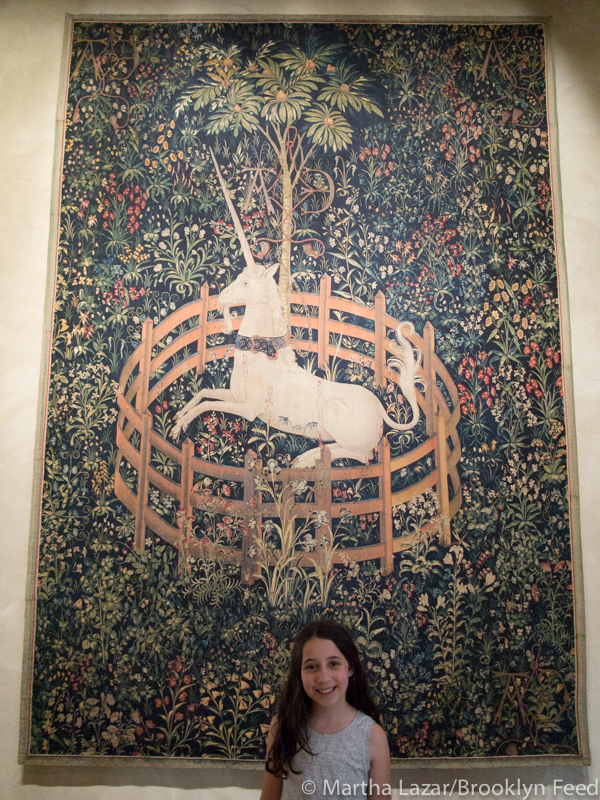 One of the unicorn tapestries.
One of the unicorn tapestries.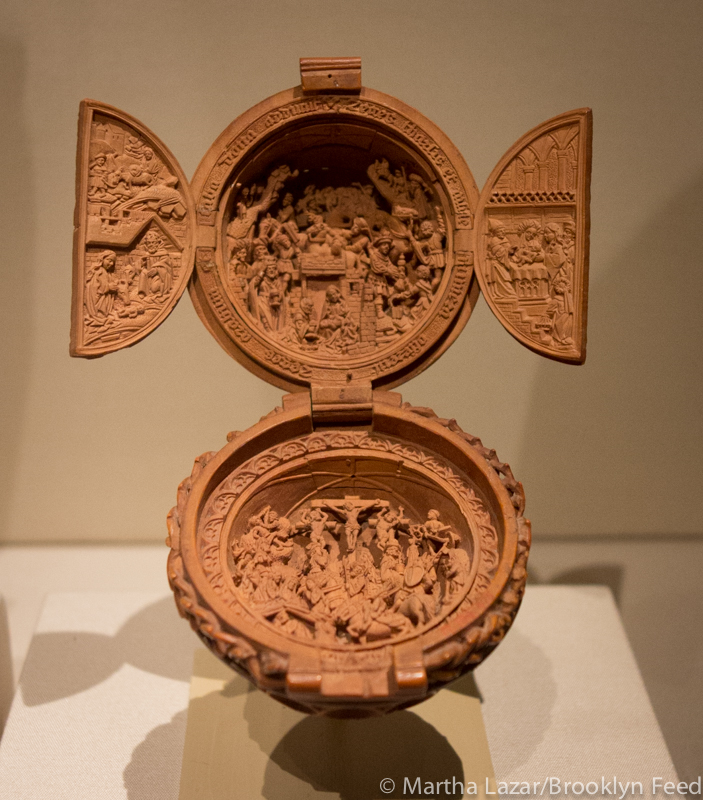 Rosary bead.
Rosary bead.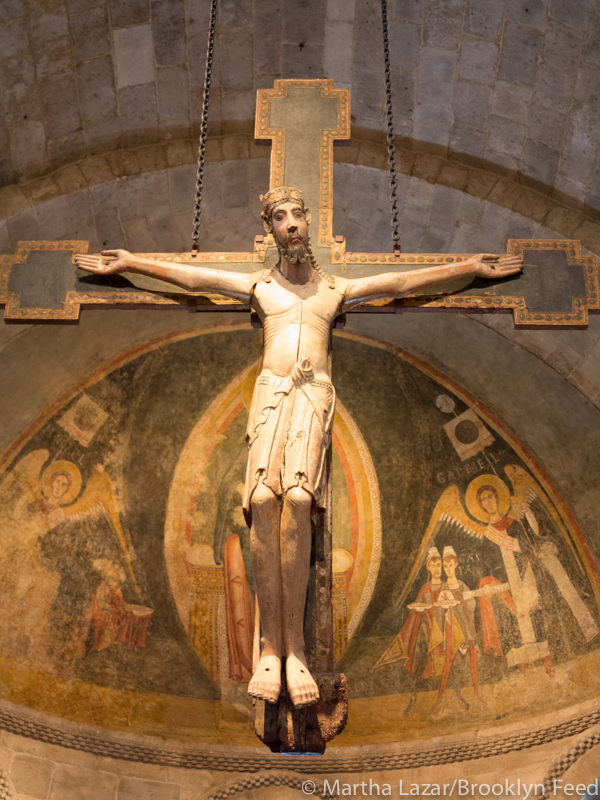 I thought this depiction of Jesus made him look as though he could actually be from the Middle East.
I thought this depiction of Jesus made him look as though he could actually be from the Middle East.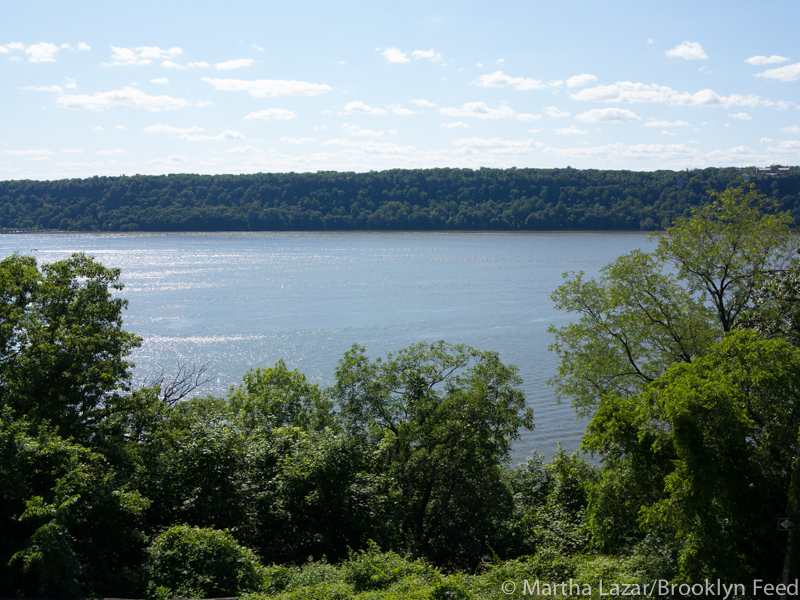 View from the Cloister’s gardens.
View from the Cloister’s gardens.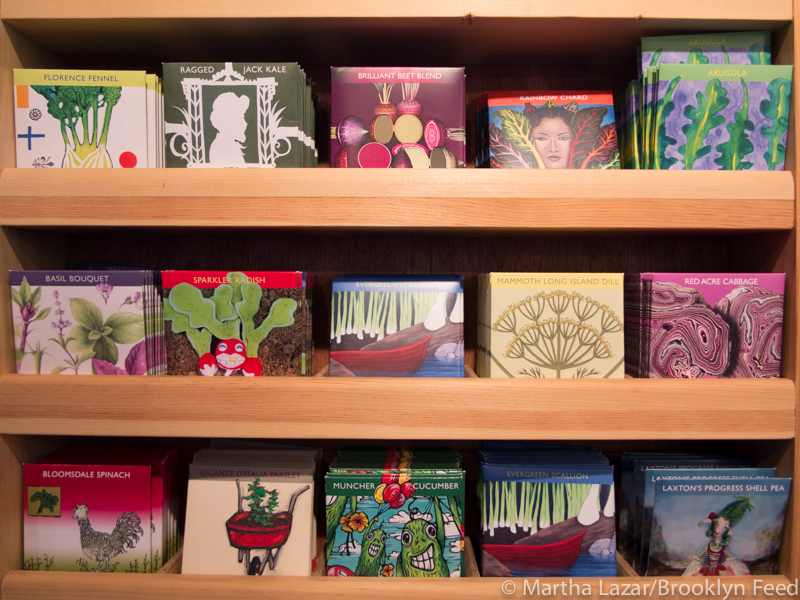 Seed packets in the gift shop.
Seed packets in the gift shop.
Bloodroot
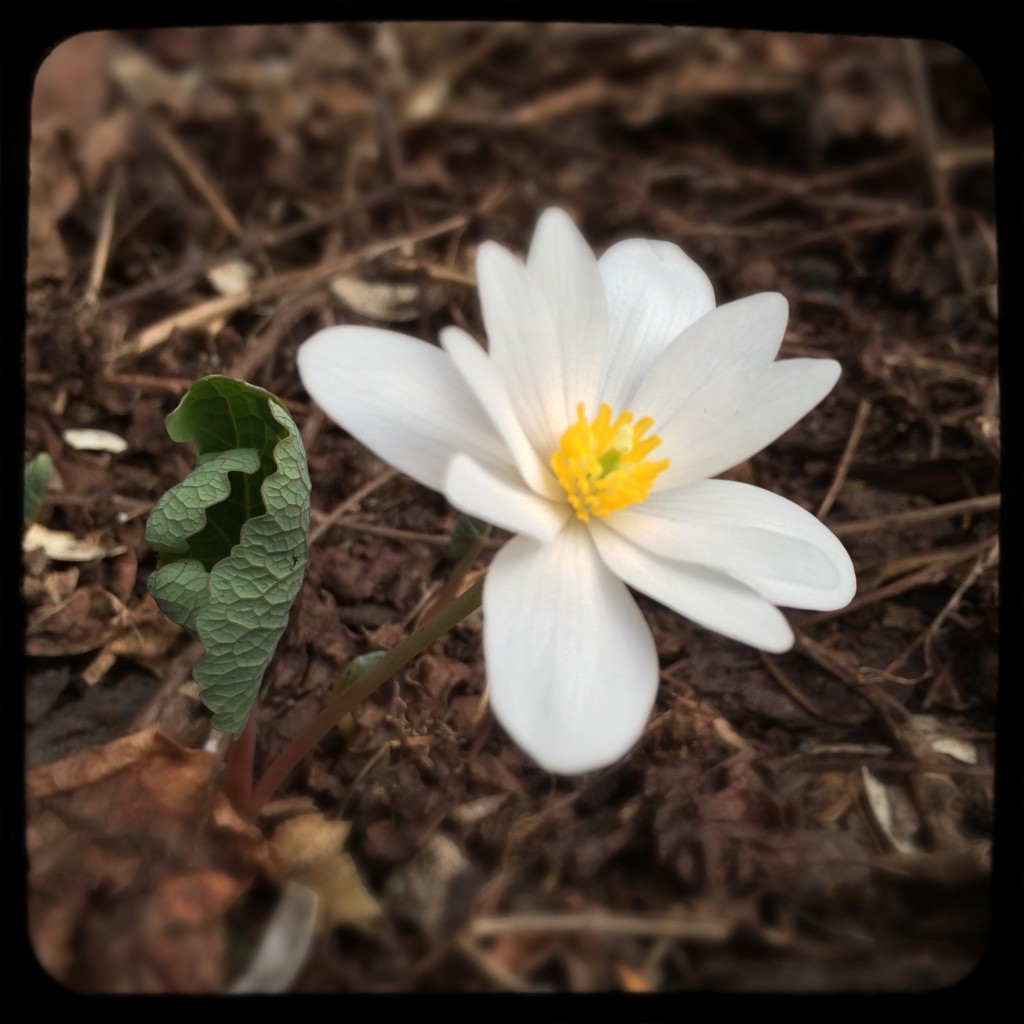 The first flower to bloom in my garden this spring is bloodroot. I got this native plant from my favorite plant nursery Project Native in Great Barrington, MA. My first encounter with this sweet flower was on a hike in early spring a couple of years ago up in the Berkshires. Although spring was definitely hitting, it was still too early for anything more than buds on the trees. As we walked along, we spied lots of these beauties popping up. They just screamed spring. There was something so hopeful about this flower springing up out of what still looked like winter. I was smitten.
The first flower to bloom in my garden this spring is bloodroot. I got this native plant from my favorite plant nursery Project Native in Great Barrington, MA. My first encounter with this sweet flower was on a hike in early spring a couple of years ago up in the Berkshires. Although spring was definitely hitting, it was still too early for anything more than buds on the trees. As we walked along, we spied lots of these beauties popping up. They just screamed spring. There was something so hopeful about this flower springing up out of what still looked like winter. I was smitten.
I bought a plant a few years ago. Last spring was to be the first time I would have bloodroot in my garden. Unfortunately I let my chickens loose in the garden and they ran right to that spot and danced a cha cha on the plant and shredded it beyond repair. I was afraid that they had killed it. Needless to say, I didn’t see a flower that year.
On my early spring rounds of the garden, when I’m searching for any signs of life, I noticed the small curled leaf of the bloodroot plant! A couple of days later the little flower opened. Isn’t it lovely?
Bloodroot (Sanguinaria canadensis) is so named because of the dark red of its root. It has been used medicinally for ages. Applying the root directly to skin, kills the cells, which has led people to try and use it as a way to kill cancer cells. It is currently added to toothpaste and mouthwash as an anti-placque and antibacterial agent.
Bloodroot grows in part shade to shade. It prefers woodlands. I have it in a particularly shady spot in my garden. It already looks as though it is spreading, so hopefully a few more blooms will pop up this spring. After it is pollinated, the petals drop off and a seedpod forms soon afterwards. I’m looking forward to seeing the whole process this year.
Crocus Sativus, part 2
I thought I would add a bit to my last post. Above you can see the saffron crocus in bloom. Those 3 crazy stamens you see are what is harvested and dried to make saffron. They kind of scream for attention, don’t they?
Backing up to the last post….after eating the paella I started thinking about the spice saffron. I knew it was the dried stamens of a particular crocus, but that was about it. And what really got me thinking was…with crocus bulbs bursting up in practically everyone’s backyards, couldn’t a saffron crocus be grown here as well?
I poked around the internet as I am wont to do, and found out a few things. The first was that the saffron crocus was actually called crocus sativus. From there the information was pretty easy. I found a bunch of nurseries that stocked the bulbs. You can get them via Amazon for goodness sake.
They grow in zones 6-8 in mostly to partly sunny spots. I couldn’t quite figure out why nobody grows these guys, especially given the exorbitant price. It is the most expensive spice in the world according to many different sources. What got me really thinking about trying it out was this article on it. The author talks about how common the saffron crocus was in Pennsylvania Dutch families, and how they might laugh at how much people spend on the spice when they had them growing next to their wood pile. Somehow that clinched it for me. Here’s another article about the Pennsylvania Dutch connection along with a recipe for chicken soup with saffron.
I planted them in my dwarf apple tree pots and put down bird netting over the soil to keep the squirrels away. The bulbs seemed quite dry and light (weight-wise), so I’m hoping that they are still viable. If nothing happens with them in the next couple of months, I may buy another batch. I read that you plant them in late summer, so I still have plenty of time if these are duds. I’m not really sure why they specify planting them in late summer as you leave them in the ground all year. I didn’t want to wait any longer with mine as they seemed quite dry already.
I am very excited to try my hand at growing it. I’ll post pictures when they start sprouting.
Crocus Sativus
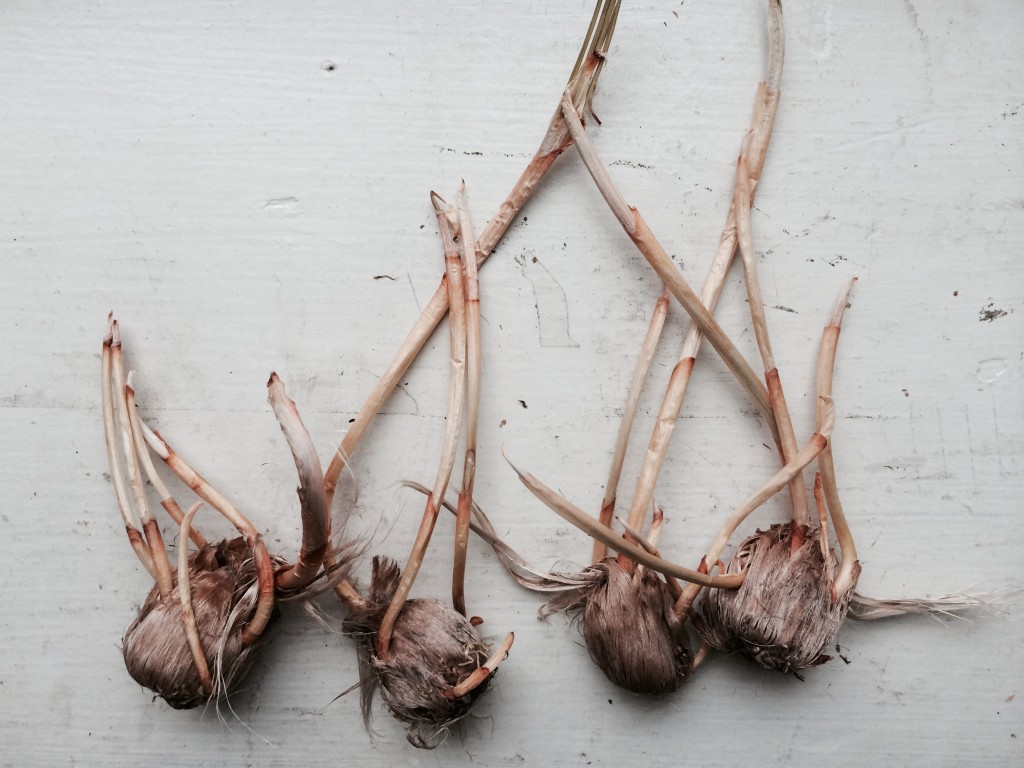 This past New Year’s, we had friends over who made the most delicious paella dish. Since then, I’ve been thinking about saffron. It is a very expensive spice that is made of the dried stigmas of a particular crocus. I started to wonder what kind of crocus produced the right stigmas, and if I could grow it in my climate.
This past New Year’s, we had friends over who made the most delicious paella dish. Since then, I’ve been thinking about saffron. It is a very expensive spice that is made of the dried stigmas of a particular crocus. I started to wonder what kind of crocus produced the right stigmas, and if I could grow it in my climate.
It turns out that the correct crocus is the Crocus sativus. It looks a lot like the regular purple ones that are popping up right now in the early Spring. The sativus crocus blooms in the Fall instead. After peeking at quite a few sites on the internet, I realized that I could grow these crocus bulbs right here in Brooklyn. Very exciting!
I ordered 10 bulbs from Marde Ross & Co. I’ve had to wait a bit because of our hard winter, but I’m planning on planting them in the big pots that hold my dwarf apple trees. I need to rig a netting barrier to prevent the squirrels from digging up these fairly expensive bulbs.
The first season, I’m told not to expect many blooms. Each year the plants multiply and produce more flowers. It will be fun to try my hand at saffron production.
Tree Support
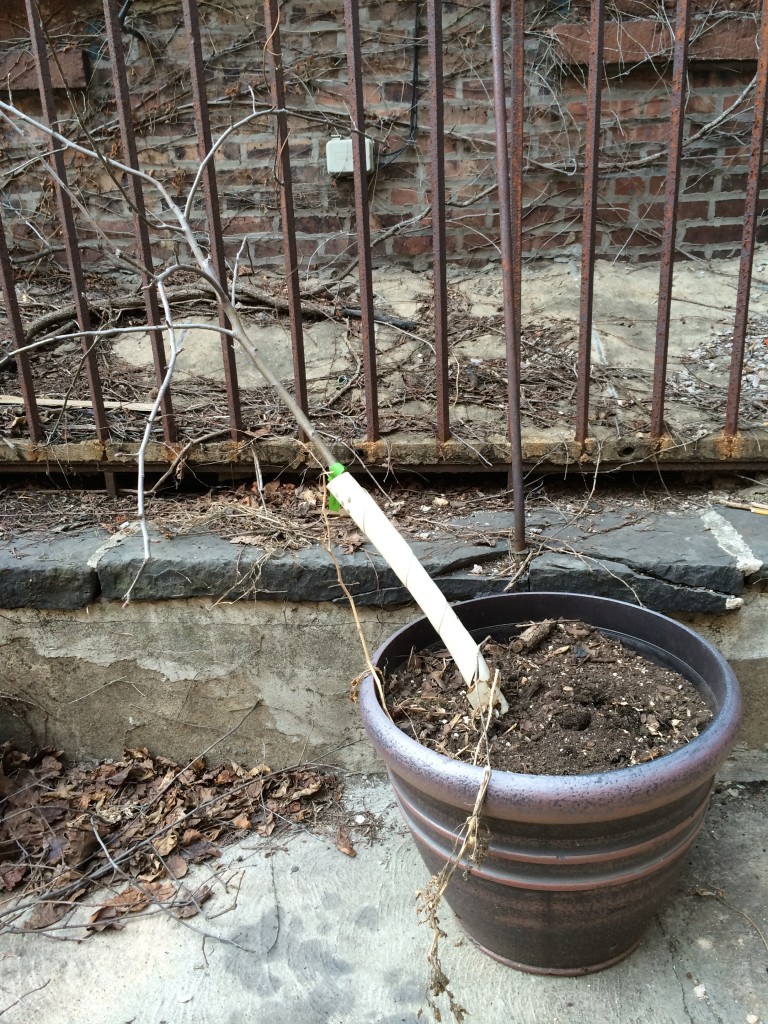 For some reason I never bought a support for this little apple tree. I have one for the other one, but somehow never got around to getting a second one. As you can see this little guy is leaning terribly. I finally decided to be a responsible adult and ordered a tree support.
For some reason I never bought a support for this little apple tree. I have one for the other one, but somehow never got around to getting a second one. As you can see this little guy is leaning terribly. I finally decided to be a responsible adult and ordered a tree support.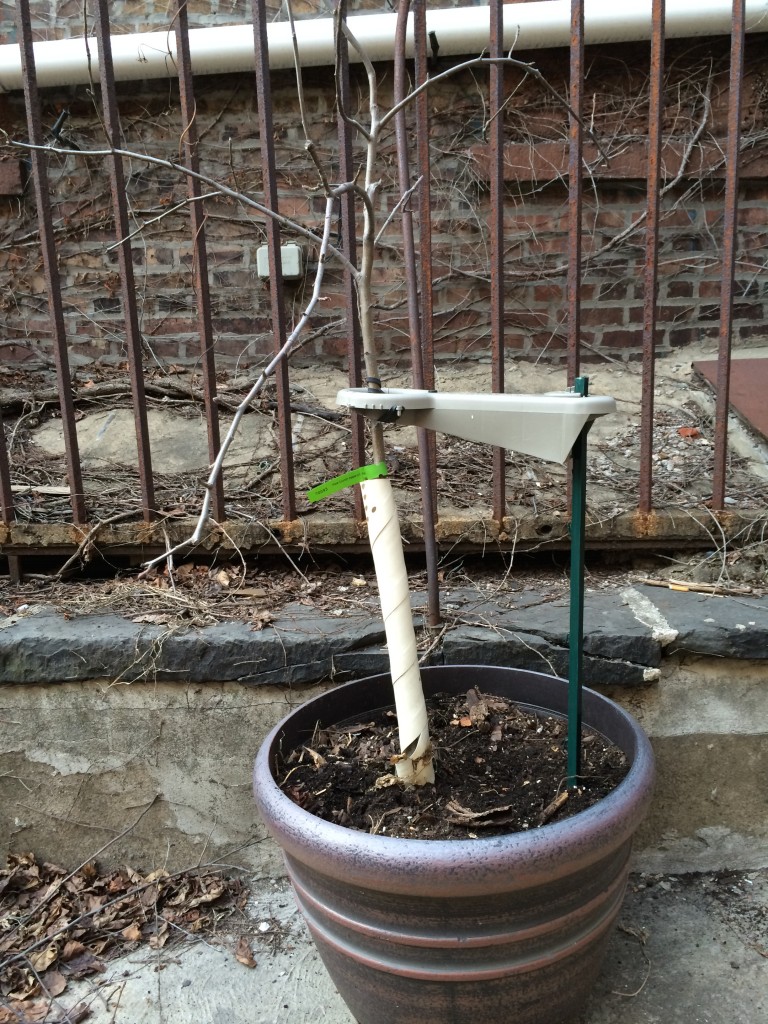 I generally don’t promote products on this site, but I like this product. It’s called Tree*Mate*O and is the light gray piece seen in the photo above. You attach it to a u-shaped post and it has a rubber band that wraps around the tree. I’ve had one for my other tree for years and it has been supporting it well.
I generally don’t promote products on this site, but I like this product. It’s called Tree*Mate*O and is the light gray piece seen in the photo above. You attach it to a u-shaped post and it has a rubber band that wraps around the tree. I’ve had one for my other tree for years and it has been supporting it well.
I attached it to my little apple tree and the tree already looks much better. The tree was leaning so far over that I didn’t want to snap it by making it completely upright in one go. So, I’m going to wait a few weeks until the tree is used to this position and then I’ll straighten it completely.
Can’t wait to see some green in the garden!
Summer
August Garden
What’s been growing in my urban garden?
This squash plant grew from homemade compost. I had no idea what kind of squash would grow, and for most of the summer, nothing did.
I just noticed that there are some small squash starting to grow. These look like one of the more exotic ones that came in our CSA. Looking forward to trying them.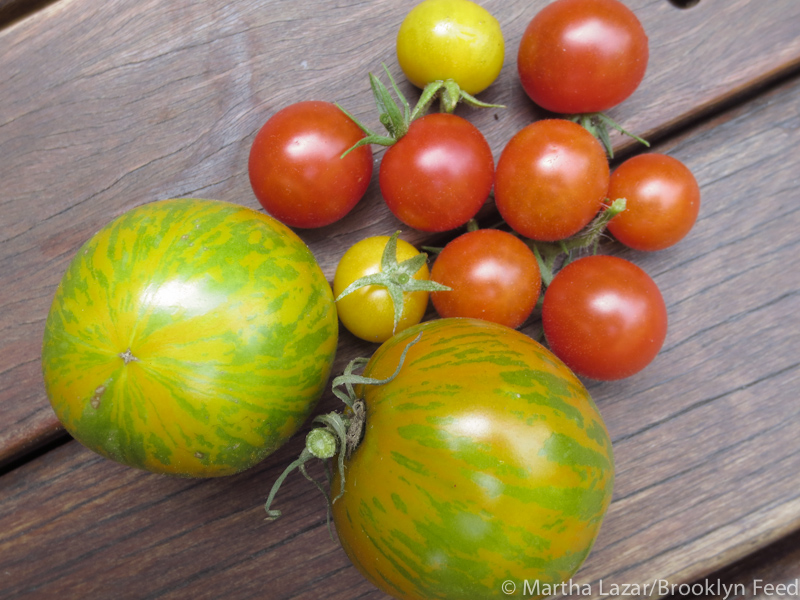
Not sure why tomatoes are deciding to grow in my garden this year, but I’m definitely not complaining. The big striped ones are green zebras, which is a lovely heirloom variety. They are tart and unsettling because of their color. We have a variety of cherries that mostly grew from compost. Unfortunately we ate all our white currant tomatoes before I took a photo of them.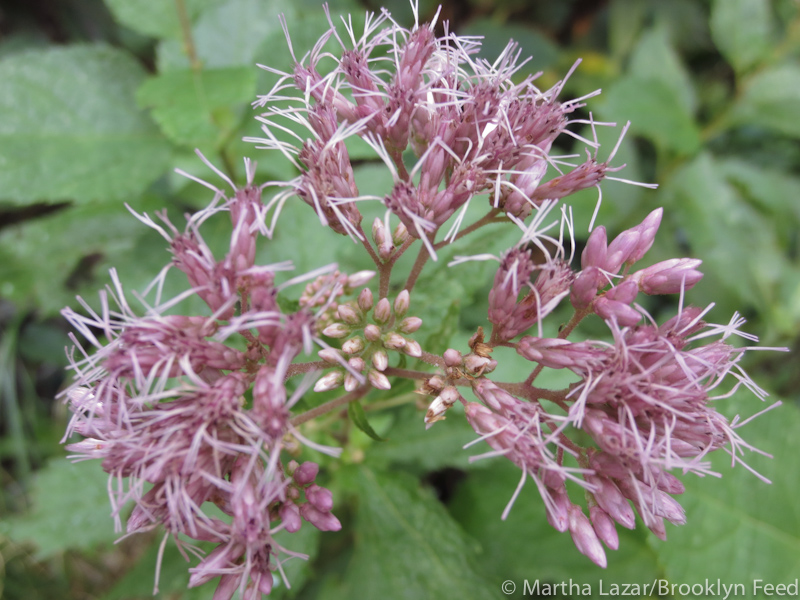
Our purple Joe Pye weed is flowering. This is one of the native plants I got from Project Native. Something is happily eating away at the leaves. I know most people don’t like to have their plants eaten, but that is part of the point of planting native varieties. I’ve given something a food source. I keep checking for caterpillars, eggs or cocoons, but haven’t seen any yet. And this crazy looking thing is a mushroom growing out of the mulch by my chickens. It’s a type called a stinkhorn. They attract all kinds of insects. You can see many sitting on the top of the one in the foreground.
And this crazy looking thing is a mushroom growing out of the mulch by my chickens. It’s a type called a stinkhorn. They attract all kinds of insects. You can see many sitting on the top of the one in the foreground.
What’s growing in your garden?
Planting Potatoes
This year we’ve decided to try a new crop to our little urban garden. Potatoes! Yukon gold in fact. I tried going the cheap route and bought some from the grocery store. After a couple of weeks trying to sprout them, I read that sometimes potatoes are soaked in something to prevent them from sprouting. Euw! Not sure what that is.
So then I decided to order “official” seed potatoes. By the time they arrived my grocery store ones started to sprout. Of course! So if the potatoes work, I will be rich with them. The potatoes are from a place in Colorado called The Potato Garden.
And since my soil is lousy and filled with glass, I looked into suitable containers for growing them. You have to have something that is deep, so you can keep adding soil (hilling) as the plants grow. This keeps the potatoes from getting hit by the sun, which causes them to turn green and be bitter. I found Smart Pots and ordered 2 of them. They are made out of a sturdy fabric. I thought I would give them a try.
As usual, I have to put my garden behind bars to keep the squirrels from destroying the unestablished plants.

